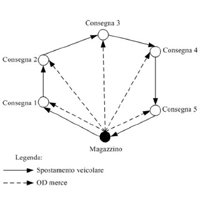Demand Forecasting Models for Urban Goods Movements
Abstract
In order to reduce the impacts of freight transport, Public Administration usually implements city logistics scenarios, whose effects have to be evaluated by using ex-ante assessment procedures. This paper proposes the state-of-the-art of models for the prediction of urban goods movements, which have been developed to support the above ex-ante assessment. Aiming at preserving the economic sustainability of the businesses located in the city and, at the same time, the environmental quality, the new challenge of urban traffic management is the optimization of the access of a large number of trucks and vans delivering goods in the urban area. Thus, the availability of a reliable tool for ex-ante assessment plays a key role in the decision making processes. Starting from the structure of urban goods distribution and its critical states, this paper identifies the decision-makers, whose choices could be influenced by city logistics measures. Furthermore, considering the outcomes and goals to be reached by Public Administration, the city logistics measures are also classified. In such way, it is possible to define the decisional processes influenced by city logistics measures, that models have to simulate. The presented modelling system allows us to forecast the OD truck flows within the study area and it consists of two sub-systems: the first related to the demand and the second related to the logistics. The former gives the OD matrices in terms of deliveries; the latter allows to convert the delivery OD flows into truck OD flows. The demand sub-system has been specified as a partial share model. From socio-economic data of the study area, it allows us to estimate the OD matrices in quantity characterized by service type, as well as the OD matrices in deliveries characterized by time slice and vehicle type. The logistic sub-system allows to estimate the OD matrices in vehicles. The modelling framework consists of two models that allow us to reproduce the commercial vehicle tours within the urban area. The former model gives the distribution of tours per number of deliveries; the latter gives the probability to choose the following destination for the next delivery.Downloads
References
Ambrosini C., Meimbresse B., Routhier J., Sonntag H. (2007) “Urban freight policy-oriented modelling in Europe”. Proceedings of City Logistics V a cura di E. Taniguchi e R. G. Thompson, Kyoto, Giappone.
Nuzzolo A., Comi A., Coppola P., Crisalli U. (2010a) “Politiche della Mobilità e Qualità delle Aree Urbane”. Guida Editore, Napoli.
Nuzzolo A., Crisalli U., Comi A., Galuppi S. (2010b) “Demand models for the estimation of urban goods movements: an application to the city of Rome”. Selected Proceedings of the 12th World Conference on Transport Research, Lisbon, Portugal.
Nuzzolo A., Crisalli U., Comi A. (2009) “A delivery approach modeling for urban freight restocking”. Proceedings of the 12th International Conference on Travel Behaviour Research (IATBR), Jaipur, India.
Russo F., Comi A. (2010) “A modelling system to simulate goods movements at an urban scale”. Transportation, DOI 10.1007/ s11116-010-9276-y, Springer Science+Business Media, LLC.
Russo F., Vitetta A. and Comi A. (2009). “Estimation of target time distribution for agri-food products by road transport”. Schedule- Based Modeling of Transportation Networks: Theory and Applications, N. H. M. Wilson and A. Nuzzolo (eds.), Springer Science + Business Media.
Wang Q. e Houlguin-Veras J. (2008). “An investigation on the attributes determining trip chaining behavior in hybrid microsimulation urban freight models”. Proceedings of the 87th Transportation Research Board Annual Meeting, Washington DC, U.S.A..
Yang C. H., Chow J. Y. e Regan A. C. (2009). “State-of-the Art of Freight Forecasting Modeling: Lessons Learned and the Road Ahead”. Proceedings of the 88th Transportation Research Board Annual Meeting, Washington DC, U.S.A.

Copyright (c) 2014 Tema. Journal of Land Use, Mobility and Environment

This work is licensed under a Creative Commons Attribution 4.0 International License.
Authors who publish in this journal agree to the following:
1. Authors retain the rights to their work and give in to the journal the right of first publication of the work simultaneously licensed under a Creative Commons License - Attribution that allows others to share the work indicating the authorship and the initial publication in this journal.
2. Authors can adhere to other agreements of non-exclusive license for the distribution of the published version of the work (ex. To deposit it in an institutional repository or to publish it in a monography), provided to indicate that the document was first published in this journal.
3. Authors can distribute their work online (ex. In institutional repositories or in their website) prior to and during the submission process, as it can lead to productive exchanges and it can increase the quotations of the published work (See The Effect of Open Access)
